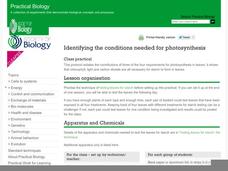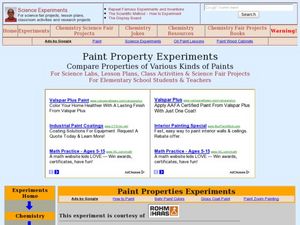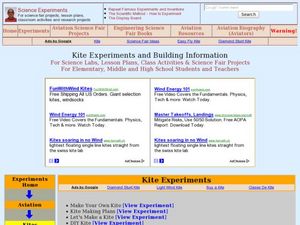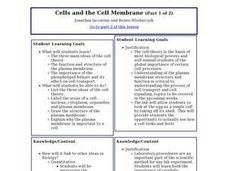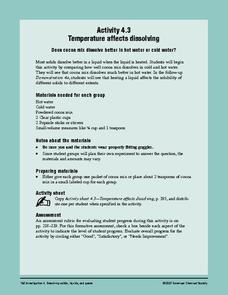Curated OER
Build a Model Submarine
Learners form lab groups and work together to construct a submarine out of a soda bottle. Next, they observe its action in a tub of water as the inner pressure is changed. It is an engaging experiment. However, links to outside resources...
Curated OER
Investigating the Effect of Minerals on Plant Growth
How do different minerals affect the growth of plants? Budding botanists find out in a multi-week experiment that has them using solutions with specific mineral deficiencies. While there is a lot of preparation for the investigation,...
Nuffield Foundation
Identifying the Conditions Needed for Photosynthesis
Budding biologists often ask how scientists know what they do about different topics. In the lab described here, they have a chance to find out first-hand about the requirements for photosynthesis. Three sequential investigations are...
University of Minnesota
Balance: The Ears Have It
Don't go around and around with the same concept! A hands-on activity explores the vestibular system and circular motion. After spinning a group member, lab partners examine their eye movement. Making observations allows the group to...
American Chemical Society
Liquids - Clearly Unique
Bring chemistry to life for scholars as they perform two tests to examine the unique properties of three liquids. Classroom investigators make observations, develop basic lab skills, and follow step-by-step instructions to compare water,...
Curated OER
Paint Property Experiments
Students identify various kinds of paints by using the scientific method. In this solvents lesson students collect data and identify paint samples while working in teams.
Curated OER
Homopolar Motor Experiments
Students construct a homopolar motor following certain procedures. In this physics lesson, students explain how generators and motors work. They compare and contrast the characteristics of both.
Curated OER
Allelopathy Experiments
Learners explore how allelopathy works in plants. In this botany lesson, students explain how this phenomenon affect other organisms. They read and analyze an article about allelopathy and discuss its flaws.
Curated OER
Kite Experiments and Building Information
Students build their own kite following certain procedures. In this physics lesson, students explain the aerodynamics concepts involved in flying kites. They trace the development of aviation.
Curated OER
Paper Chromatography K-12 Experiment
Students study chromatography and how they can distinguish between the different pigments in a color. For this chromatography lesson students separate a mixture of dyes in soluble ink then record the colors they see.
Curated OER
Floor Polish Experiments
Young scholars compare various brands of floor polishes and test their durability and appearance. In this floor polish activity students test different polishes and check performance.
Curated OER
Applied Science - Science and Math Post-Lab
Students explore optical illusions. In this Applied Science instructional activity, students view optical illusions and record the data of what they see. Students graph the data that they collect.
Curated OER
Testing Water for Hardness Using Soap Bubbles K-12 Experiments & Background Information
Students examine water and what causes it to become hard. In this water lesson plan students use the soap test and determine the mineral content and hardness of a sample of water.
Curated OER
Applied Science - Technology Lab
Students concoct glue. In this Applied Science lesson, students experiment with different amounts of flour and water to make their own glue. Students use their glue for a paper mache project.
Curated OER
Applied Science - Science and Math Lab
Students explore the senses. In this Applied Science lesson, students investigate the items in "feely" boxes with their hands, both touching the items and shaking the boxes to hear the sound the items make. Students also smell and taste...
Curated OER
Integers and Science Worksheet.
In this science worksheet, students incorporate their knowledge of math to solve the given problems about freezing points through conversions. They convert from unit to the other. There are 10 questions.
Curated OER
Cells and the Cell Membrane
Students investigate the properties of cell membranes by isolating the membrane surrounding chicken eggs. They set up an experiment by placing eggs in a vinegar solution for three days. A powerpoint lecture emphasizes the structure of...
Curated OER
The Gummy Worm Lab
Students participate in a lab experiment with gummy worms. In groups, they record the qualitative and quantitative observations during the lab. They use their senses to make inferences about the experiment and share them with the class.
Towson University
Mystery of the Crooked Cell
Can your class solve the Mystery of the Crooked Cell? Junior geneticists collaborate to learn about sickle cell anemia in a fascinating lesson plan. The included materials help them to examine the genetic factors behind the disease...
Curated OER
Testing for Life’s Molecules
Want to hear a joke about sodium? Na. Young scientists test various materials to identify if they include protein, starch, and glucose by using the Biuret test, iodine starch test, and Benedict's test respectively. After practicing with...
Curated OER
Riding on a Pendulum
A comprehensive resource gets fourth grade physical scientists making observations about the period of a pendulum and then applying knowledge to a playground swing. Through seven different stations, they will record observations and...
Captain Planet Foundation
Worm Your Way Out of This
How can you provide healthy soil for your garden? Study worms, bacteria, and other microorganisms in a lesson plan about decomposition and organic compost. After discussing what you know about worms and watching a video, watch what worms...
American Chemical Society
Temperature Affects Dissolving
Stir chocolate drink mix into hot and cold water to see if there is a difference in how quickly it dissolves. Number three in a six-lesson unit on dissolving, this installment investigates the effect of temperature. If you consult the...
American Chemical Society
Energy Foundations
Only 10 percent of an incandescent bulb's energy is used to create light; the remaining 90 percent is heat. In the unit of activities, young chemists examine energy through hands-on activities, videos, discussions, and...


